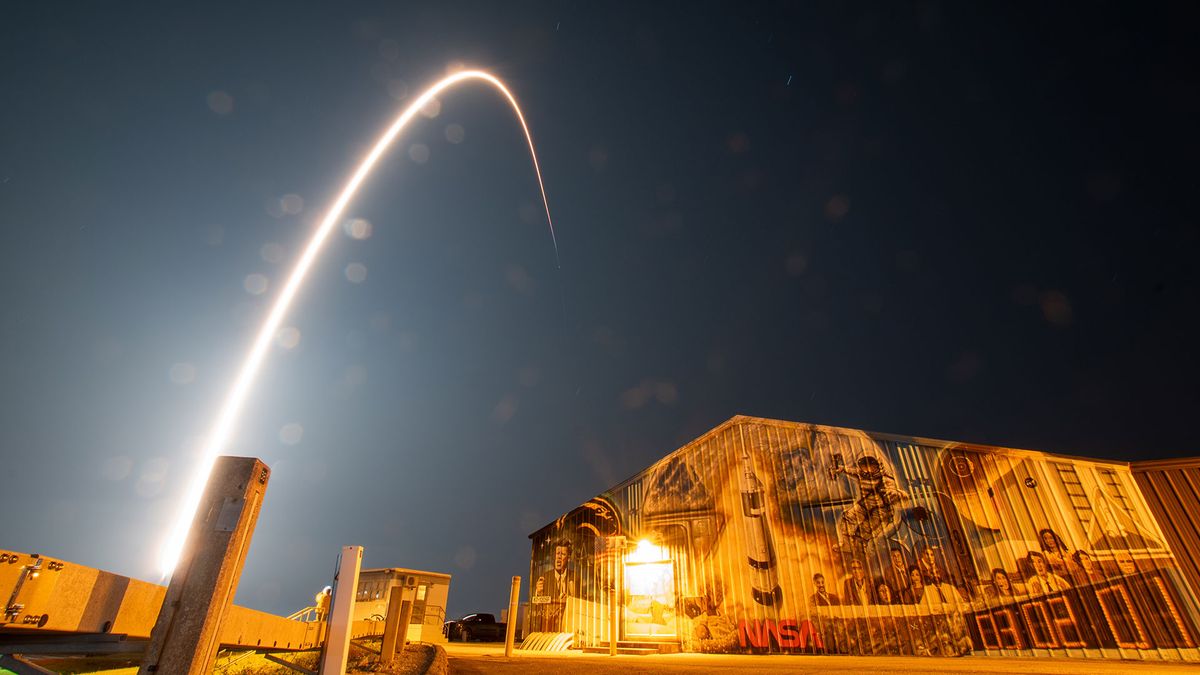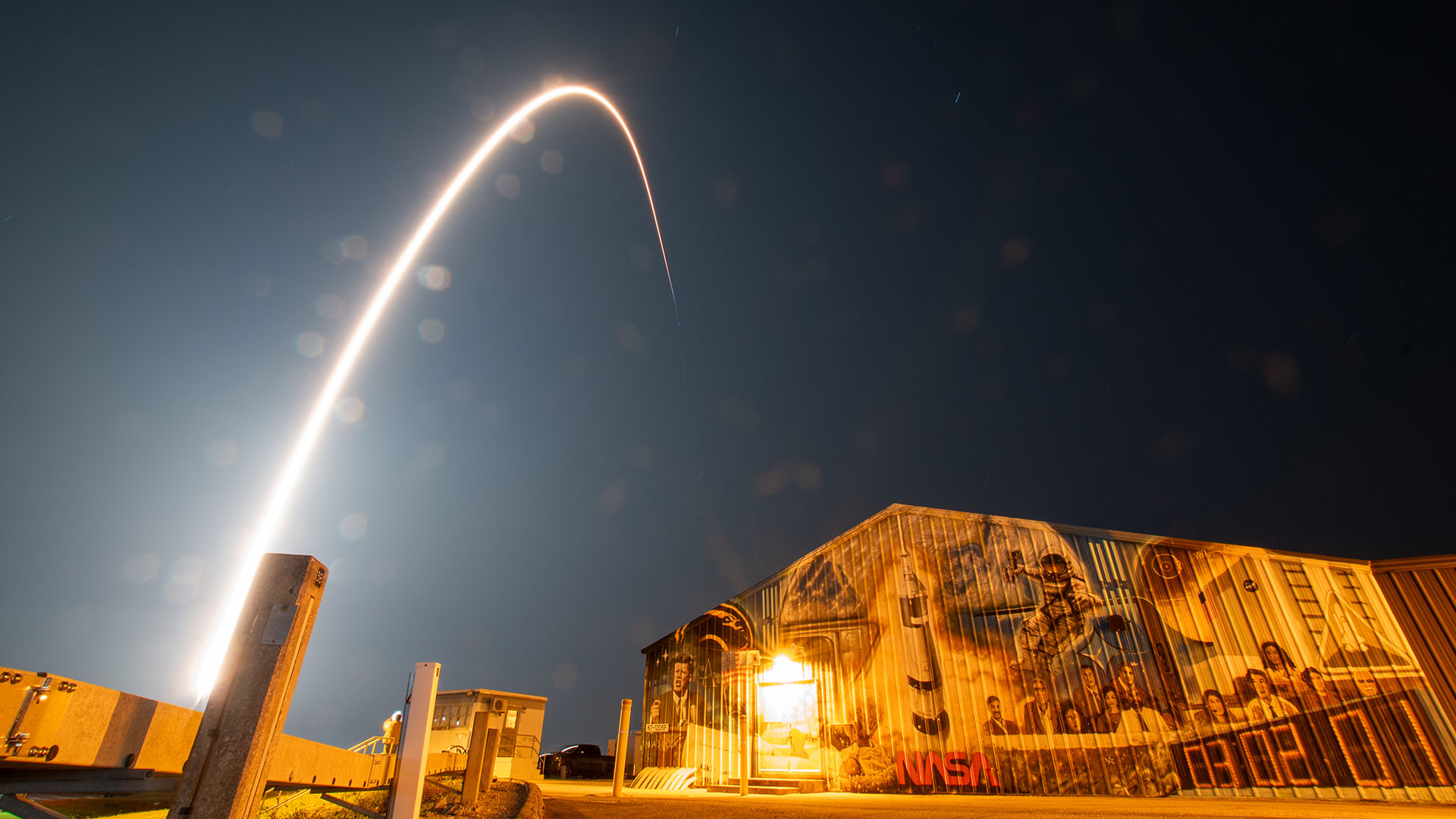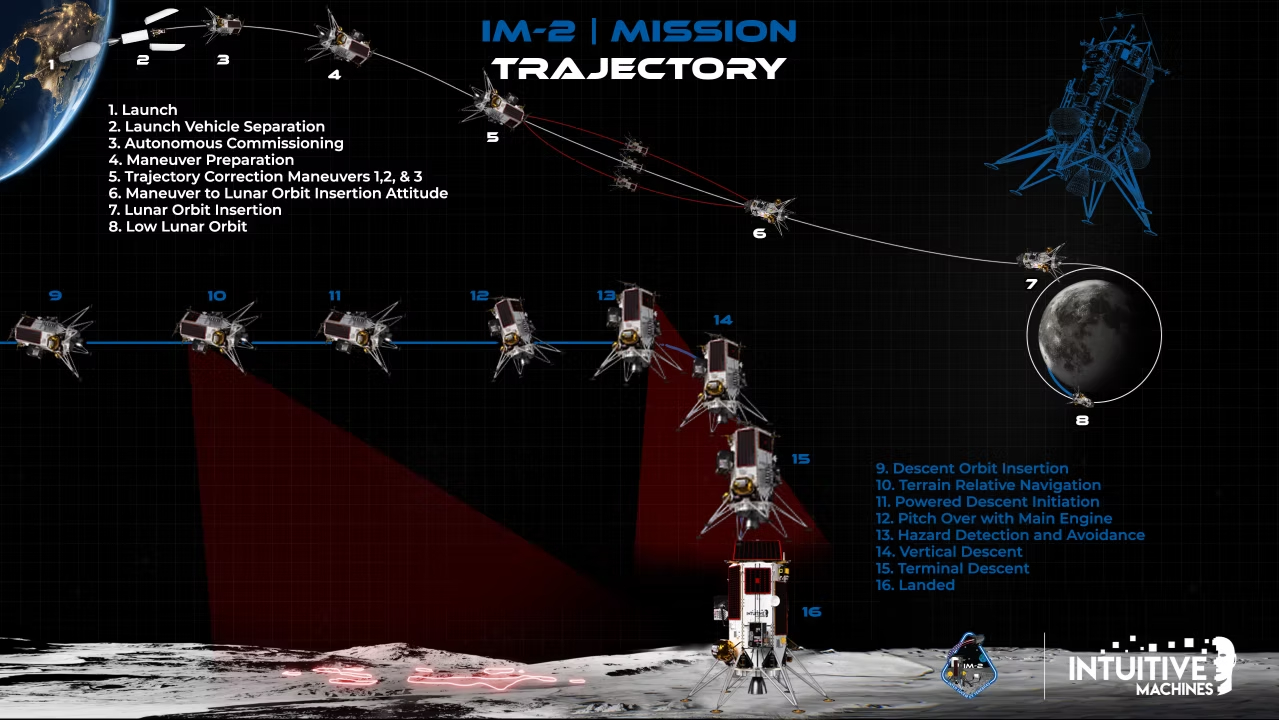
CAPE CANAVERAL, Fla. — The private lunar lander Athena is en route to the moon.
A SpaceX Falcon 9 rocket launched just after sunset on February 26, carrying Athena along with NASA’s accompanying Lunar Trailblazer orbiter into the night sky from NASA’s Kennedy Space Center (KSC).
Athena, designed by the Houston-based company Intuitive Machines, is equipped with 10 scientific instruments from NASA, many focused on detecting water ice. The Lunar Trailblazer orbiter will conduct similar investigations from its higher orbit. This mission is part of NASA’s broader goal to establish human habitats on the moon through the Artemis program.
“I’m thrilled to see the scientific results from our technology demonstrations as we prepare for the return of humans to the moon and our mission to Mars
The Falcon 9 lifted off from KSC’s Launch Complex-39A at 7:16 p.m. EST (0017 GMT on February 27). Approximately 8.5 minutes post-launch, the rocket’s first-stage booster successfully returned to Earth, landing on the SpaceX droneship “A Shortfall of Gravitas,” marking the ninth launch and landing for this Falcon 9 booster (B1083). The upper stage of the Falcon 9 continued on, deploying Athena into a translunar injection orbit 43.5 minutes after liftoff, with Lunar Trailblazer following just four minutes later. Athena’s mission, designated IM-2, marks the second lunar venture in two years for Intuitive Machines and is part of NASA’s Commercial Lunar Payload Services (CLPS) program, which aims to foster partnerships to deliver scientific and technological payloads to the moon. Athena will primarily investigate the presence of water ice and other valuable resources near the lunar south pole, crucial for the sustainable habitation of space — a process termed in-situ resource utilization (ISRU). To accomplish the objectives of IM-2, the lander is equipped with two secondary units: a mini rover called MAPP (Mobile Autonomous Prospecting Platform) from Colorado’s Lunar Outpost and a “hopper” robot named Grace from Intuitive Machines, designed to navigate the vicinity around the landing site through a series of jumps. The IM-2 mission follows the milestone IM-1 mission, launched by Intuitive Machines in February 2024, on a similar CLPS mission. The IM-1 lander, “Odysseus,” achieved the first-ever soft lunar landing by a private spacecraft, but it sustained damage upon landing, affecting data transmission. “This time, we hope to achieve a more accurate landing,” stated Trent Martin, Intuitive Machines’ senior vice president of space systems, in an interview with Space.com before the launch. Athena is targeted to land in the Mons Mouton area on the moon, believed to contain significant water ice deposits pertinent to ISRU studies. If successful, the lander will enter lunar orbit in about four to five days and land approximately 1.5 to three days later, followed by a mission duration of around 10 Earth days. Its primary scientific payload is known as PRIME-1 (Polar Resources Ice Mining Experiment 1), which comprises two key instruments: the Regolith Ice Drill for Exploring New Terrain (TRIDENT) and the Mass Spectrometer observing lunar operations (MSolo). Together, they’ll gather and analyze samples from beneath the lunar surface, with TRIDENT capable of reaching depths of up to 3 feet (1 meter) to extract material for MSolo’s evaluation of compounds such as water and carbon dioxide. The IM-2 hopper, dubbed “Grace” after the renowned computer scientist Grace Hopper, will explore areas up to almost 1 mile (1.6 kilometers) around Athena’s landing zone. Grace utilizes its thrusters, inertial measurement unit, star tracker, lidar, and a situational awareness camera to bound across the lunar terrain. It aims to investigate the permanently shadowed floor of a nearby crater, which traditional rovers cannot access. Due to the crater’s shadowy conditions, Grace will require MAPP to assist in relaying communications with Athena. MAPP is tailored to deploy on the moon to validate the capabilities of the Lunar Surface Communications System (LSCS) — designed by Nokia Bell Labs — showcasing a novel cellular network integrated with existing 4G/LTE technologies. Athena is also equipped with a Laser Retro-Reflector Array (LRA), featuring eight mirrors that will test laser light reflection for improved positioning of spacecraft in orbit, akin to runway reflectors for landing aircraft, functioning without any power or mechanical control. Meanwhile, Lunar Trailblazer is set to map lunar water ice deposits from its orbit, providing complementary data alongside Athena’s PRIME-1 findings. “This will help us broaden our understanding of lunar resources and potential applications across different lunar regions,” stated Lunar Trailblazer Principal Investigator Bethany Ehlmann to Space.com prior to the mission.
NASA initially contracted the IM-2 mission for $47 million, but costs have escalated to $62.5 million over the years due to various adjustments from NASA, including a request for temperature data from one of Athena’s onboard instruments, according to Joel Kearns, deputy associate administrator for exploration at NASA’s Science Mission Directorate. “This contract provides us with the possibility to pay for unique data, instead of just equipment, made obtainable through this commercial mission,” Kearns elaborated. Once Athena reaches lunar orbit, it will be accompanied by two additional missions — IM-2 and Lunar Trailblazer mark the third and fourth lunar missions of 2025. Also on their way to the moon are Firefly Aerospace’s Ghost Riders in the Sky mission and Japan’s ispace with their Resilience lander, both launched in January, and expected to land shortly ahead of Athena. These missions also fall under NASA’s CLPS program, tasked with delivering various scientific instruments and technology payloads to the lunar surface. Although ispace’s Resilience mission does not include NASA’s objectives, they are contracted to collect lunar regolith samples for NASA, legally securing ownership of the samples without immediate plans to return them to Earth. Additionally, the Falcon 9 rocket carried other payloads into space today, including Odin, a spacecraft from asteroid-mining firm Astroforge, and CHIMERA GEO 1, an orbital transfer vehicle by Epic Aerospace. Editor’s note: This article was updated at 8:15 p.m. ET on February 26 with confirmation of successful spacecraft deployment.










